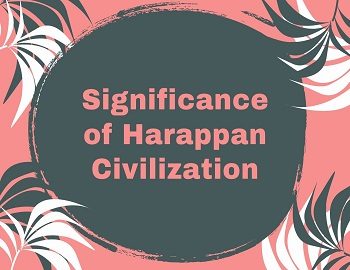Significance of Harappan Civilization:
- Harappan Civilization was one of the earliest civilizations in the world. Above all, the Harappan region was included in that selected region which manifested urbanization for the first time.
- If we observe minutely we find that even after the decline of the Harappan Civilization the idea and the experience of urbanization did not disappear but they made their contribution to the second urbanization which appeared in Gangetic valley later.
- One of the features of the Harappan Civilization was the developed town planning. Although it soon disappeared but the town planning of the Harappan Civilization influenced the nature of town planning in India in future.
- Harappan people were at a better level of development in metal technology. They used the better quality of stone-blades. Furthermore, they improved better quality of copper and bronze implements. After the decline of the Harappan Civilization, the knowledge of technology was spread to rural areas. So, as the result of the contact with the Harappan people prosperous village developed even in the backward region. After the decline of Harappan Civilization, the spread of chalcolithic cultures in different parts of the Indian subcontinent proves that the Harappan people popularized the knowledge of copper.
- Harappan Civilization made a contribution to the development of agriculture. Two crop system, the use of ploughshare etc. were a great contribution of Harappan people in the field of agriculture. Likewise, the Harappan people started the production of different crops. A multiplicity of crops was the contribution of the Harappan agrarian economy. For example- wheat, barley, peas, mustard, black gram, cotton etc. Later these crops became part of the crop-system in India.
- Harappan Civilization provided to the Indian subcontinent the legacy of scientific and technological knowledge. For example- Harappan people got meticulous achievement in mathematics and geometry. They were having knowledge of the decimal system and the binary system. Apart from that, they started the use of the wheel in making potteries, The use of the wheel also led to the development of transportation. Furthermore, Harappan people were using standard weight and measures, seals etc. They continued even during a subsequent period. Likewise, Harappan people were having knowledge about metal-forging. People from next-generation also benefited from their knowledge.
- The dietary habits, dress, way of life of Harappan people became part of Indian life. In Harappan society, we can manifest a basic structure of Indian Society. Harappan society was a divided society. At the upper level, there were members from the ruling class as well as the priest class and at the lower level, there were merchants, artisans, clerks and the working class who were taking participation in production. Likewise, in rural areas, we find a large population of cultivators and cattle-breeders. Later all these elements merged into Indian life possibly the priest class of Harappan Civilization played an important role in giving religion ritualistic from during the subsequent period.
- Existing Hindu religion is indebted to Harappan religion to a greater extent, worship of mother goddess, worship of Lord Shiva, tree cult, animal cult, fire cult, water cult, Bhaktism and the concept of rebirth all were part of the religious life of Harappan people. Later they mixed with Aryan elements in the field of religion. So up to the 8th century, A.D. Hinduism developed.
- Even in the development of art and architecture in India Harappan Civilization is having its contribution. Brick structures in Harappan Civilization remind us of brick structures during the modern age. Likewise, terracotta figures which are being made even today are having some similarity with terracotta figures under Harappan Civilization. Harappan people were making human figures with a heavy stomach, the same trend continues even today. We find some similarities even in making animal figures. When we observe minutely we find that Harappan animal figurines become an inspiration for animal figures on Ashokan pillars. Furthermore, the bullock carts, which are still plying on Indian roads, were manufactured first under Harappan Civilization.
In this way, we can underline a wide extent of contribution of the Harappan Civilization in the development of Indian society and culture. Above all significance of this civilization lies in the fact that whenever we open the pages of history we feel proud of the fact that we are among selected communities that developed urban civilization in the world.









Comments (No)